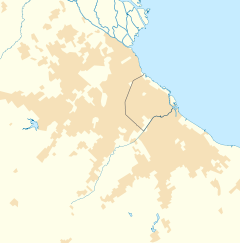Ezeiza, Buenos Aires
| Ezeiza | |
|---|---|

City Hall
|
|
| Location in Greater Buenos Aires | |
| Coordinates: 34°50′S 58°31′W / 34.833°S 58.517°WCoordinates: 34°50′S 58°31′W / 34.833°S 58.517°W | |
| Country |
|
| Province |
|
| Partido | Ezeiza |
| Founded | July 17, 1885 |
| Elevation | 12 m (39 ft) |
| Population (2010) | |
| • Total | 160,219 |
| Demonym(s) | Ezeizenses |
| CPA Base | B 1804 |
| Area code(s) | +54 11 |
| Website | Official website |
Ezeiza (Spanish pronunciation: [eˈseisa]) is the capital city of the Ezeiza Partido within the Greater Buenos Aires area in Argentina. The city had a population of 160,219 in 2010. Ezeiza is one of the fastest-growing cities in Argentina; the city and its surroundings are known for the many gated communities there, as well as for the Ministro Pistarini International Airport. Ezeiza and its surroundings is an affluent area where many well-to-do people live.
Inhabited originally by the Querandí people, the land was first claimed by the Conquistadores in 1588. The first estancia (Los Remedios) and chapel in the area were founded by Juan Guillermo González y Aragón in 1758; one of González's great-grandsons was Manuel Belgrano, one of the most notable leaders of the Argentine War of Independence. Gerónimo Ezeiza bought land nearby in 1767, and by the late 19th century his descendant José María Ezeiza became the largest landowner in the area. Following his death, Ezeiza's son-in-law donated land to the Buenos Aires Western Railway, and the town was founded around the new line on July 17, 1885; it was named in honor of the late José María Ezeiza.
Dairy farming dominated the Ezeiza landscape during the early 20th century. The town was chosen as the site of the nation's first international airport, which was inaugurated on the northern end of the city in 1949; a new neighborhood, Barrio Uno, was built just north of the airport that year to house its employees, and the Ricchieri Freeway was opened in 1952 to connect the new airport to the city of Buenos Aires. The National Atomic Energy Commission established the Ezeiza Atomic Center, a leading producer of radioisotopes for medical use, in 1967. The freeway was scene of the Ezeiza Massacre, in which at least 13 died in clashes between left and right-wing Peronists vying for the best vantage points from which to view the motorcade for exiled former President Juan Perón upon his return to Argentina on June 20, 1973.
...
Wikipedia

